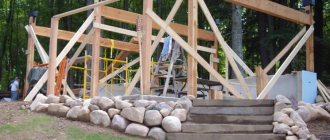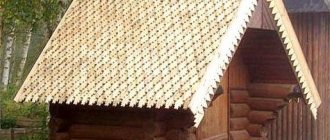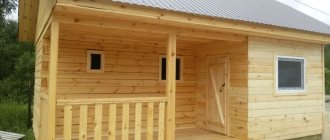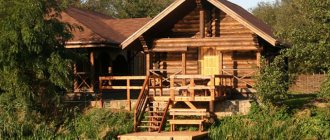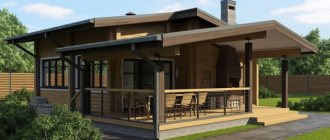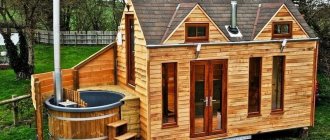Sketch of a budget bath
Before you start building a bathhouse, you need to decide on its design. It is enough to draw on a piece of paper what will be located and where approximately.
You need to understand the location of the sewer system, how water will flow, how electrical wires will be installed, and so on.
Design work
The construction of the bathhouse must be carried out in compliance with the requirements of Building Codes and Regulations 02/30/97. The building assumes the presence of: a covered canopy, a relaxation room, a washing room, a steam room, and a bathroom.
The design stage includes the development of working drawings for the general construction part, special interior finishing work, water and electricity supply, sewerage system, natural and forced ventilation system.
Materials for the construction of an economical bathhouse
- A budget version of a bathhouse can be built from timber. For a summer bath at a summer cottage, a 10 cm thick beam is suitable. The dowels should be installed at a distance of 1 meter. Such a bath has many advantages. There is no need to finish the walls here. It looks beautiful. A log sauna is not afraid of moisture. They have a long service life, the main thing is to properly care for them. This bathhouse has only one drawback. And it lies in the fact that the building is sagging.
- Arbolit. Such a bathhouse is built from cement, water, sawdust, lumber and sand. It will take a lot of time to build such a bathhouse. This material does not like water. Therefore, it will still be necessary to finish the walls, at least in the washing room.
- Warm frame. The thickness of the wall of a summer bath can be 10 cm. The most budget-friendly wall insulation will be ecowool. It is also safe because it does not burn.
- Gas silicate. The material itself is inexpensive, but you will still have to spend money on wall cladding, because it absorbs water. During construction you will also need a concrete mixer.
- Brick. A bathhouse made from such material will be expensive and difficult to build on your own. You will definitely have to hire specialists to lay the walls. After all, if you make a mistake when building a brick bathhouse, it can fall apart at any moment.
Sewage system
When constructing the foundation, installation holes should be provided at the required level for laying sewer pipes. A drainage well up to one and a half meters deep is installed not far from the bathhouse. Then they fill it with large crushed stone to one third of the depth of the well, cover it with a wooden lid and install a ventilation mushroom.
The receiving manifold is made of plastic pipes with a diameter of 100 mm with a natural slope of five degrees. Wastewater receivers are installed from the washing department, sanitary unit, and only then proceed to the installation of floors.
Bathhouse foundation
- For a bathhouse made of timber, you can lay blocks on the ground that will support the corners of the building.
- Used tires are suitable for building the foundation.
- If the site for building a bathhouse is not level, then it is necessary to dig a trench and fill it with concrete.
- Instead of digging a trench, you can use screw piles. They are screwed into the ground using levers.
What is the difference between Finnish and Russian?
The Finnish sauna uses heat-reflecting screens that create a “thermos” effect in the steam room. They are corrugated metal or crumpled foil with a shiny surface.
It is enough to install screens under the wall cladding of the heater furnace. There are also a few additional differences:
- The Finnish sauna is often dry. The heat will be evenly distributed throughout the body, warming painful areas and joints.
- In the bathhouse, due to high humidity, the temperature can reach 65 degrees. In this case, even the internal organs will warm up.
Before starting design, it is advisable to consult a doctor. Not every person today can afford to visit a Russian bathhouse.
Roof for a bath
- A flat roof is considered the cheapest.
- It is better to choose corrugated sheeting as a roof. Although roofing felt is cheaper, such a roof will not last long.
You can save on corrugated sheets if you buy illiquid goods. Such a product can be purchased at the factory. Usually there is a good discount on them. Illiquid does not mean bad. The price is reduced even because of a small dent, which does not play a special role and is not visible at all.
More information about insulation
Cheap modifications cannot be called useless; a budget DIY sauna will be quite warm and airtight with such materials
When choosing a specific manufacturer, you need to pay attention to permission to use such a component for buildings of this type.
Among environmentally friendly thermal insulation solutions, it is worth noting basal wool and penofol. The properties of both materials have proven themselves quite well, and the price will be affordable for every average family.
Thanks to convenient rolls and a wide selection of product thicknesses, you can easily choose the right option at an affordable price.
Bath shelves
Their width is about forty centimeters. They are usually made from pine or oak.
How to make a steam room
- Linden and aspen boards are used to decorate the steam room. Stone and ceramics are also suitable.
- Coniferous wood is not used because it releases resin when heated.
Which one is more environmentally friendly?
A bathhouse made from natural logs is always more environmentally friendly. It has a characteristic smell of fresh wood. It's a pleasure to be in it. She “soars and gives health.”
The frame is insulated with insulation containing various artificial materials. Only its supporting structure, the frame itself, will be environmentally friendly.
Glued laminated timber contains chemicals. Obviously, a building made from natural lumber meets these parameters best.
Mobile sauna on a summer cottage
Such a budget sauna at the dacha can be easily and simply assembled with your own hands. Two people will be able to assemble a structure from a tent, a bag and a stove on their own.
The sizes of such baths can vary. At least three people can wash in them. The temperature in the mobile sauna reaches 90 degrees.
This design can be easily transported from place to place using a trailer. After each use, the mobile sauna is washed and dried.
Features of the construction of a dugout bathhouse
- You can build it yourself.
- No foundation needed.
- Costs for walls are reduced.
- The pit is very difficult to build.
- One person is not enough to build such a bathhouse.
- With the help of construction equipment, such a bathhouse will be built faster, but money will be spent.
Marking
After choosing a place to place the building, you need to mark the territory. To do this, you need to transfer the size of the building to the terrain.
Pegs that are driven into the future corners of the bathhouse will help with this. It is important to ensure that the angles are exactly right. Further actions depend on the foundation:
- Slab. Expensive, chosen only when absolutely necessary. They are marked either exactly in size, or a little wider so that the foundation extends beyond the building;
- Tape. The most used, relatively cheap, high quality. The marking is carried out so that the concrete tape runs along the perimeter and under the partitions;
- Columnar. Also popular, most often refers to buildings made of wood. They are marked based on the size of the bathhouse and the number of supports made;
- Screw. Some people think that this method is a recent development, but it is not. It has been serving in various buildings for many years and performs well. Its advantages are the ease and speed of installation, as well as the unnecessary need for earthworks. And such a foundation is not afraid of uneven terrain. The marking is carried out precisely, based on the number of piles.
Secrets of building a bathhouse (answers from the master)
- Building materials must be certified. After all, you can buy a fake.
- Consult a specialist when building a bathhouse.
- Stoves should not be homemade. It's safest to buy it in a store.
- Sockets and wires must be protected.
- You can buy building materials in small quantities. For example, there are often promotions on some building materials in stores. You can save a lot of money if you buy everything you need at discounts.
- The steam room should be small.
- It is better to build a bathhouse on level ground. This saves money when building the foundation.
- The foundation doesn't have to be complicated.
- Before building a bathhouse, you must first look at budget bathhouse projects. Then decide for yourself what to build the foundation from. You need to understand how the sewerage system will run, how to install electrical wiring, and so on.
- The smaller the size of the bathhouse, the less money will be spent on its construction.
- It should not be located next to other buildings.
- It is better to choose a flat place to build a bathhouse.
- The roof of the bathhouse must be flat. This is one of the cheapest and simplest options when building a bathhouse.
- If the choice fell on a bathhouse made of timber, then larch is most suitable. Because when wet it only becomes stronger.
- A bathhouse built from a frame is difficult to insulate.
- The window in the bathhouse should not be too small. Also, a large window is not good either. The optimal size for a window is 50*50.
The stove should not be homemade. It must be purchased in a special store. A homemade stove is dangerous to use, although it is more economical.
Pros of DIY construction
- You can save money on construction by purchasing materials only on sales.
- Construction control is thorough.
Disadvantages of DIY construction
- Construction times may be delayed.
- A lot of effort and time is wasted.
- If you can’t build something, then you need to look for workers for spot work.
Insulation and vapor barrier
A frame bathhouse is not insulated - when constructing the frame, thermal insulation is immediately installed in it. A wooden structure needs a sheathing where the necessary material will be laid. But other types require more complex work.
You will need mineral wool, the thickness depending on the climate conditions and the type of bath. As a rule, the layer thickness is about fifty millimeters. The insulation itself can be either mats or rolls.
Vapor barrier is very different from waterproofing. The first one will do its job perfectly, even if it’s cheap, while the second one will only ruin everything.
Therefore, you need to be careful not to confuse them and not buy a fake.
Photo of a budget sauna
Wiring
To organize lighting inside the bathhouse, it is necessary to supply electricity from a residential building or from a power line pole located closer to the building. Do-it-yourself wiring installation in a building for washing procedures and rest consists of the following steps:
- calculation of the required amount of cable and electrical fittings;
- purchase of necessary tools and materials;
- direct installation of electrical wires and electrical accessories.
To ensure fire safety, a separate panel with regulators is installed in the bathhouse. Due to the periodic use of the building, high temperatures and humidity, it is necessary to conduct electricity in compliance with regulations.
Wiring diagram
A schematic drawing of a plan for the internal power line in an individual building will help to accurately calculate the cable length and mark the intended placement of sockets, switches, and junction boxes, if necessary. It should be noted that sections of electrical wiring laid to sockets must have a cross-section capable of withstanding a greater load than those laid to lighting sources.
It would be useful to calculate the total and partial power required to power all devices and appliances. You can sketch out the floor plan of your house on a certain scale yourself. On the project, mark the expected trajectory along which the electrical network will be laid.
Necessary materials
Modern requirements oblige owners to place an electric meter outside a residential building or on the outer wall of a bathhouse. You can also install a circuit breaker there that cuts off the power to the building completely. The list of necessary materials for installing electrical wiring is as follows:
- cables and wires with different sections, including hermetically insulated ones for laying wiring outside and in rooms with high humidity;
- electrical panel or electric meter with a protective box;
- cable channels with corners, dowel clamps or staples, depending on the mounting method you choose;
- electrical accessories: switches, sockets, distribution boxes;
- lighting devices for rooms with high humidity and temperature changes;
- self-tapping screws for fastening cable ducts and installing sockets and switches.
When purchasing, choose materials for wiring that have a protective layer against moisture and are resistant to high temperatures. This will prevent the shell from melting and shorting.
List of required tools
To install the internal electrical network yourself, prepare the following tools:
- hammer drill with impact mode and drill bits;
- screwdrivers;
- pliers;
- screwdriver;
- knife.
To decorate the electrical wire and install channels, prepare self-tapping screws.
Electrical wiring installation
In accordance with the plan of the designed wiring from the electrical panel or electric meter, the installation of which should be entrusted to qualified specialists, use a pencil to make notes on the proposed line of future electrical wiring. In accordance with the drawing, install distribution boxes to evenly distribute the load across all rooms.
According to the European standard, sockets in the rest room can be installed 30 cm from the floor. If there are small children in the family, you should purchase sockets with protective curtains or plugs. According to European standards, switches are located 90 cm from the floor. Install switches for the washing room and steam room in a room with little heating.
Select all lighting fixtures for a bath taking into account the specifics of the room where they will be used. For washing and steam rooms, it is necessary to use lamps made of heat-resistant materials treated with anti-corrosion compounds. A competent approach, taking into account all the nuances and features when laying electrical wiring in a bathhouse, will save you from hassle and ensure a safe and comfortable stay.
Project creation stages
- Decide on a building site;
- Note the landscape features and soil characteristics;
- Determine the depth of groundwater;
- Indicate the number of people who can be in the bathhouse at the same time;
- Draw a preliminary plan of the bathhouse indicating the number of rooms;
- Allocate the required area for each room;
- Imagine the location of furniture and internal elements (fireplace or stove, sockets and light bulbs); Decide on the presence or absence of a pool inside the bath complex.
Finishing facilities
For exterior finishing, plastering and painting would be an excellent option. For plastering, a solution of cement and sand is prepared in a ratio of 1:4.
The walls are plastered twice and then rubbed down. After the plaster has completely dried, acrylic paint is applied to its surface. The choice of colors depends on your taste preferences.
When starting interior decoration, it is necessary, first of all, to insulate the walls. At intervals of 50 centimeters, beams are fixed to the walls. Next, insulation is placed in the gaps.
A vapor barrier membrane or foil is attached to the insulation. Foil is often used as such a membrane, and indeed recommended. The sheathing is attached on top of the foil. The facing material is fixed to it.
Wood is most often used as a facing material for a bathhouse. For long-term use, the wood must be treated with water-repellent impregnation.



